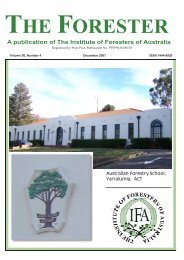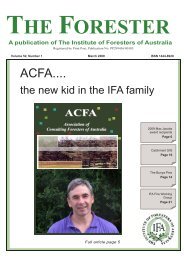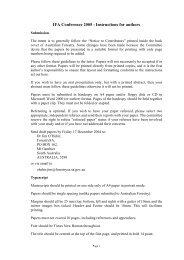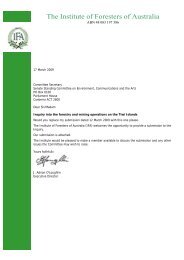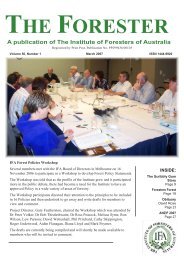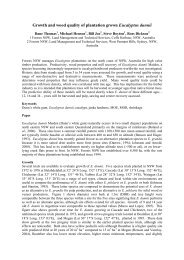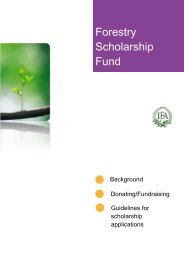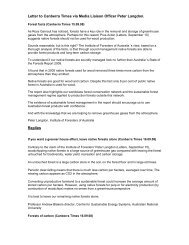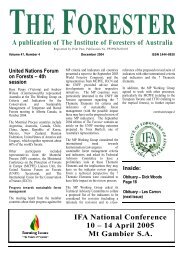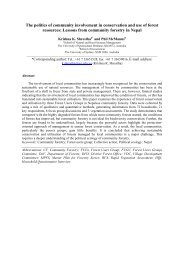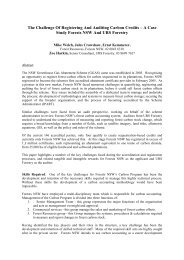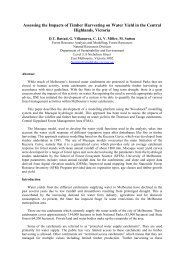The Permanent Forest Sink Initiative - Institute of Foresters of Australia
The Permanent Forest Sink Initiative - Institute of Foresters of Australia
The Permanent Forest Sink Initiative - Institute of Foresters of Australia
You also want an ePaper? Increase the reach of your titles
YUMPU automatically turns print PDFs into web optimized ePapers that Google loves.
<strong>The</strong> <strong>Permanent</strong> <strong>Forest</strong> <strong>Sink</strong> <strong>Initiative</strong><br />
PAPER PRESENTED TO THE AUSTRALIA AND NEW ZEALAND INSTITUTE OF<br />
FORESTRY CONFERENCE, JUNE 2007.<br />
Author: Robert Miller 1<br />
Abstract<br />
<strong>The</strong> <strong>Permanent</strong> <strong>Forest</strong> <strong>Sink</strong> <strong>Initiative</strong> (PFSI) is a New Zealand Government initiative which will allow<br />
landowners and investors to invest in new or recently established forests for the purposes <strong>of</strong> carbon<br />
sequestration. Landowners who establish forests under the PFSI will be able to earn tradable carbon<br />
credits which are recognised under the Kyoto Protocol for at least the first commitment period from<br />
2008-2012. International recognition and rules associated with carbon sinks post-2012 are still<br />
subject to future negotiations.<br />
PFSI landowners will have to meet all costs associated with generating carbon credits and agree to<br />
‘replace’ any carbon credits should there be a decrease in the carbon stored in the forest. <strong>The</strong>se rights<br />
and obligations will be formalised in a contract between landowners and the Crown. <strong>The</strong>se contracts<br />
will be registered against land titles and will bind future landowners.<br />
In addition to earning Kyoto-compliant carbon credits, PFSI forests may also be harvested for timber.<br />
Harvesting can occur on a continuous canopy basis.<br />
<strong>The</strong> legislation, regulations and operational procedures enabling the PFSI are expected to be in place<br />
in 2007.<br />
What is the <strong>Permanent</strong> <strong>Forest</strong> <strong>Sink</strong> <strong>Initiative</strong> (PFSI)?<br />
<strong>The</strong> PFSI is a government initiative that promotes the establishment <strong>of</strong> permanent forests on<br />
previously un-forested land. <strong>The</strong> initiative enables landowners to generate income through “carbon<br />
forestry” – removing carbon dioxide from the atmosphere and storing it in new forests. PFSI land<br />
owners will be able to claim Kyoto-compliant carbon credits for increases in the amount <strong>of</strong> carbon<br />
stored in their forest.<br />
<strong>The</strong> PFSI will be administered by the Indigenous <strong>Forest</strong>ry Unit (IFU) <strong>of</strong> the Ministry <strong>of</strong> Agriculture<br />
and <strong>Forest</strong>ry (MAF). More information about the PFSI is available on MAF’s website<br />
(www.maf.govt.nz/forestry/pfsi/).<br />
<strong>The</strong> PFSI is likely to be favoured in marginal lands in New Zealand’s hill country where farming is<br />
less pr<strong>of</strong>itable or where roading infrastructure does not exist to support traditional commercial<br />
forestry.<br />
Why the PFSI?<br />
<strong>The</strong> PFSI provides an opportunity for landowners and investors to invest in forests grown for carbon<br />
and to sell carbon credits. <strong>The</strong> initiative is expected to be broadly neutral to the Government in, its net<br />
position. <strong>The</strong> PFSI does however potentially generate a number <strong>of</strong> important co- benefits:<br />
<strong>The</strong> scheme encourages new afforestation – particularly in areas which have been traditionally<br />
marginal for commercial forestry<br />
It provides farmers with additional income generating land use options<br />
It provides farmers with options for <strong>of</strong>fsetting green house gas emissions from livestock and other<br />
farming activities<br />
It provides Government with a further source <strong>of</strong> credits to purchase to help meet its Kyoto target<br />
1 Manager, Indigenous <strong>Forest</strong>ry Unit, Ministry <strong>of</strong> Agriculture and <strong>Forest</strong>ry, robert.miller@maf.govt.nz
It provides an additional mechanism for central and local government to promote sustainable land<br />
management - managing erosion and water quality<br />
PSFI improves the financial viability <strong>of</strong> establishing indigenous forests and other slow growing<br />
species<br />
A range <strong>of</strong> species/forest types are encouraged; leading to greater biodiversity<br />
Legislation and Implementation<br />
Part 3B <strong>of</strong> the <strong>Forest</strong>s Act 1949 provides for the implementation <strong>of</strong> the PFSI. <strong>The</strong> legislation is<br />
available from www.legislation.co.nz. This enabling legislation for the PFSI was passed in late 2006.<br />
<strong>The</strong> detailed operational requirements for the PFSI will be contained in two forms:<br />
Regulations;<br />
A covenant agreement between the landowner and the Government.<br />
<strong>The</strong> scheme is expected to become operational before the end <strong>of</strong> 2007 once operational procedures are<br />
in place and regulations are approved. <strong>The</strong> Ministry <strong>of</strong> Agriculture and <strong>Forest</strong>ry is currently<br />
consulting on: regulations, costs recovery and a draft forest sink covenant. <strong>The</strong>refore, some <strong>of</strong> the<br />
details may still be subject to change.<br />
Regulations for the PFSI are currently under development. <strong>The</strong>se will provide for:<br />
eligibility requirements;<br />
empower the government to enter into covenants;<br />
allowable harvesting levels;<br />
carbon accounting requirements;<br />
transfer <strong>of</strong> carbon credits to and from landowners;<br />
record keeping requirements; and<br />
government cost recovery.<br />
<strong>The</strong> PFSI covenant is an agreement between the government and the landowner which is registered<br />
against the land title in perpetuity. <strong>The</strong> covenant defines the forest area, sets out the obligations <strong>of</strong> both<br />
parties and includes a management plan.<br />
<strong>The</strong> legislation, regulations and operational procedures enabling the PFSI are expected to be in place<br />
in 2007.<br />
Relationship to the Kyoto Protocol<br />
New Zealand has ratified the Kyoto Protocol. New Zealand will account for forests under Article 3.3<br />
but has elected not to account for any Article 3.4 activities. Under Article 3.3 New Zealand must<br />
assess, over the first commitment period (2008-12), the change in carbon stocks in new forests<br />
established since 1990.<br />
<strong>The</strong> New Zealand Government has opted to retain all Kyoto forest sink credits and liabilities for Kyoto<br />
forests (those established since 1990) apart from forests established under the PFSI. Holders <strong>of</strong> PFSI<br />
covenants will be entitled to receive Kyoto compliant carbon credits in proportion to the increase in<br />
carbon stocks in the PFSI forests over the first Commitment Period. In addition, PFSI participants will<br />
be liable for any reduction in carbon stocks.<br />
<strong>The</strong> PFSI operates under the Kyoto emissions trading regime. It is not a “project” under the Joint<br />
Implementation (JI) mechanism.<br />
If the Kyoto Protocol no longer allows emission units to be generated from the forest, then all<br />
harvesting restrictions will be removed – though, to the extent that CO2 emission liabilities remain in<br />
respect <strong>of</strong> units already claimed; these liabilities will need to be met by landowners if the carbon stock<br />
declines.<br />
Eligibility
To be eligible for this initiative the land must not have been covered in forest as at 31 December 1989<br />
and the forest must be "direct human induced ... through planting, seeding and/or the human-induced<br />
promotion <strong>of</strong> natural seed sources.” A forest is defined according to the definition New Zealand has<br />
adopted for accounting under the Kyoto Protocol.<br />
A “<strong>Forest</strong>” is a minimum area <strong>of</strong> land <strong>of</strong> 1.0 hectare with tree crown cover (or equivalent<br />
stocking level) <strong>of</strong> more than 30 per cent with trees with the potential to reach a minimum<br />
height <strong>of</strong> 5 metres at maturity in situ. A forest may consist either <strong>of</strong> closed forest formations<br />
where trees <strong>of</strong> various storeys and undergrowth cover a high proportion <strong>of</strong> the ground or<br />
open forest. Young natural stands and all plantations which have yet to reach a crown density<br />
<strong>of</strong> 30 per cent or tree height <strong>of</strong> 5 metres are included under forest, as are areas normally<br />
forming part <strong>of</strong> the forest area which are temporarily unstocked as a result <strong>of</strong> human<br />
intervention such as harvesting or natural causes but which are expected to revert to forest.”<br />
In addition, Kyoto-compliant land containing exotic forest is eligible to enter PFSI only if the forest<br />
was established after 17 October 2002 (the date the PFSI was first announced). All Kyoto-compliant<br />
land containing indigenous forest is eligible to enter the PFSI.<br />
Applicants must provide evidence that the land is eligible. This will normally be aerial photography<br />
taken at or close to 1990 that clearly shows the land use at that date.<br />
Species<br />
<strong>The</strong>re are no restrictions in the species that qualify for the PFSI provided that they meet the above<br />
Kyoto definition <strong>of</strong> being able to grow to 5m or taller at maturity in situ and meet the eligibility<br />
criteria discussed above. <strong>The</strong> species chosen will depend on the growing site and the objectives <strong>of</strong> the<br />
investor or landowner. A factor to consider in the selection <strong>of</strong> species is not just the site – species<br />
interaction or the rate <strong>of</strong> biomass accumulation but also its fitness for management under a continuous<br />
cover management regime which is a requirement <strong>of</strong> the PFSI at least for the first 99 years (see<br />
below).<br />
Shade tolerant species which can persist under their own canopy or the canopy <strong>of</strong> other species are<br />
essential for this form <strong>of</strong> management to ensure that carbon stocks continue to increase in the long<br />
term. In the New Zealand environment shade tolerant species <strong>of</strong> interest include indigenous species<br />
such as silver beech (Noth<strong>of</strong>agus menziesii) and tawa (Beilschmiedia tawa), many <strong>of</strong> the exotic<br />
cypresses, redwood (Sequoia sempervirens) and Western Red Cedar (Thuja plicata). Douglas fir<br />
(Pseudotsuga menziesii) fits into the medium shade tolerant category which may not easily lend itself<br />
to continuous cover management with small coup sizes (Maclaren et al). Seral vegetation such as<br />
kanuka and manuka and exotic gorse can play a significant role in the early development <strong>of</strong> forests;<br />
<strong>of</strong>ten making up the major part <strong>of</strong> the carbon pool.<br />
Establishment <strong>of</strong> indigenous forests is making a resurgence in New Zealand. This may happen in the<br />
PFSI either by direct planting or seeding or by actively promoting natural regeneration through a<br />
change in land use out <strong>of</strong> farming into forestry. For those interested in maximizing returns from<br />
carbon sequestration in a shorter time period then fast growing species will be the species <strong>of</strong> choice.<br />
<strong>The</strong>se include Eucalytpus species, Pinus radiata, Douglas fir, cypresses such as Cupressus<br />
macrocarpa and C lusitanica, coastal redwood and poplar species. Most tend to be light demanding<br />
pioneer species however and management plans will need to address the succession into climax<br />
vegetation with the risk <strong>of</strong> significant carbon loss.<br />
Carbon sequestration rates in New Zealand forests typical range from 2-5 tonnes <strong>of</strong> CO2 equivalent<br />
per year mean annual increment for slower growing mixed podocarp/hardwood forests to 25-35 tonnes<br />
per ha for fast growing species like radiata pine.
Figure 1. Indicative Carbon Sequestration Rates 2<br />
Tonnes C02/ha<br />
1600<br />
1400<br />
1200<br />
1000<br />
800<br />
600<br />
400<br />
200<br />
0<br />
1 4 7 101316192225283134374043464952<br />
Age ( years)<br />
Manuka (Leptospermum) Totara ( Podocarpus)<br />
Mixed podocarp/hardwood Pinus radiata<br />
Douglas fir<br />
Allowable harvesting levels<br />
Harvesting <strong>of</strong> the forest is permitted on a continuous cover basis. Under continuous canopy forestry,<br />
participants will be allowed to harvest up to 20 percent <strong>of</strong> the forest’s basal area per hectare (applied to<br />
any given hectare). <strong>The</strong> forest must then recover to the pre-harvest basal area before trees can be<br />
harvested again. This restriction will be removed from a forest after the forest has been part <strong>of</strong> the<br />
PFSI for 99 years.<br />
Figure 2.<br />
Tonnes CO2/ha<br />
1000<br />
900<br />
800<br />
700<br />
600<br />
500<br />
400<br />
300<br />
200<br />
100<br />
0<br />
Continuous Cover Management<br />
1 4 7 10 13 16 19 22 25 28 31 34 37 40 43 46 49 52 55 58<br />
Age (yrs)<br />
Participants who breach the harvesting restrictions will be required to ‘replace’ carbon credits for the<br />
CO2 released, plus make a penalty payment. <strong>The</strong> penalty payment will be additional carbon credits<br />
calculated on the basis <strong>of</strong> an annual compounding rate <strong>of</strong> 10 percent applied to each year’s carbon<br />
credits received, commencing from the earliest year in which the units were generated. Penalties are<br />
only payable for breaches <strong>of</strong> allowable harvesting limits and NOT for CO2 emitted for other reasons<br />
such as fire, disease or wind throw.<br />
2 Note that the “dips” in the curves for Pinus radiata and Douglas fir assume an early thinning is carried out for stand improvement
Carbon Accounting System for PFSI<br />
MAF are currently developing a carbon sequestration accounting methodology for the PFSI. While<br />
New Zealand is already establishing systems for accounting for carbon stock changes in forests at a<br />
national level under the LULUCF principles <strong>of</strong> the Kyoto Protocol these operate at a coarser level than<br />
the stand level monitoring required for the PFSI.<br />
<strong>The</strong> following principles guide the development <strong>of</strong> the PFSI carbon accounting system:<br />
(a) A system in which participants have some flexibility within defined limits but get “rewarded”<br />
for providing more precise estimates;<br />
(b) Has an acceptable likelihood that Government is not giving out more carbon credits than what<br />
it claims under the Kyoto Protocol for PFSI forests as a whole;<br />
(c) Aims to be reasonably site specific, so that factors such as management decisions aimed at<br />
increasing carbon sequestration rates (such as stocking rates, species, and tending decisions)<br />
and site productivity are recognised;<br />
(d) Estimates carbon emissions and removals in accordance with good forestry practice;<br />
(e) Balances accuracy with cost effective data acquisition and input requirements;<br />
(f) Accounts for carbon in all 5 carbon pools 3 but with flexibility to exclude carbon pools which<br />
are <strong>of</strong> marginal benefit to measure if this delivers a positive net cost benefit to the covenant<br />
holder; provided that it takes into account pools which are or become a source;<br />
(g) Accounts for carbon stock changes for any species or forest type established under the PFSI;<br />
(h) Will provide conservative carbon sequestration estimates where only coarse information<br />
exists, including in respect <strong>of</strong> information for specific carbon pools;<br />
(i) Uses the best available information and can be updated, developed and refined overtime as<br />
new research acquires more information;<br />
(j) Produces a report showing all the data inputs, assumptions, and an estimate <strong>of</strong> the uncertainty<br />
<strong>of</strong> the calculation and the final carbon stock at a specific time;<br />
(k) Can be made available for stakeholder or public use through a web-based user interface;<br />
MAF is investigating 2 options for assessing carbon stock changes:<br />
(a) measurement through a system <strong>of</strong> permanent or temporary plots established randomly<br />
(b) modelling - using estimated parameters such as stocking/canopy cover and average height<br />
applied to growth models.<br />
Measurements will be more costly but would be expected to generate a more reliable estimate <strong>of</strong><br />
carbon (depending on sampling error) and therefore potentially a higher level <strong>of</strong> carbon credits<br />
allocated than a modelled approach.<br />
Use <strong>of</strong> Certifiers<br />
Participants will be required to arrange their own assessment <strong>of</strong> carbon stock changes in accordance<br />
with the PFSI carbon accounting methodology. This will need to be signed <strong>of</strong>f by an approved certifier<br />
registered with MAF. Certifiers would have to maintain independence and impartiality from<br />
participants.<br />
MAF would audit a proportion <strong>of</strong> the work undertaken by these certifiers.<br />
MAF has proposed that certifiers must be New Zealand <strong>Institute</strong> <strong>of</strong> <strong>Forest</strong>ry (NZIF) registered forestry<br />
consultants 4 or have appropriate competencies. This should:<br />
• provide an additional level <strong>of</strong> confidence in the mechanism;<br />
• assist in reducing the time MAF spends ensuring the quality <strong>of</strong> certifiers;<br />
• provide a means <strong>of</strong> dispute resolution which is impartial and fair<br />
• provide a code <strong>of</strong> ethics for certifiers.<br />
Transfer <strong>of</strong> carbon credits<br />
3 Above ground live biomass, below-ground live biomass, deadwood, litter, and soil organic matter<br />
4 Further information regarding NZIF and NZIF registered consultants can be found at www.nzif.org.nz.
A participant will be transferred carbon credits on the basis <strong>of</strong> a report certified by a registered<br />
certifier and approved by MAF which assesses the change in carbon sequestered in the forest over the<br />
first commitment period (and potential future commitment periods). This report will need to use the<br />
carbon sequestration accounting methodology or methodologies specified in the regulations.<br />
Holders <strong>of</strong> PFSI covenants will be entitled to receive Kyoto compliant carbon credits in proportion to<br />
the increase in carbon stocks in the PFSI forests over the first commitment period. In addition, PFSI<br />
participants will be liable for reductions in carbon stocks.<br />
PFSI forests generate removal units 5 (also known as RMUs or sink credits) for the Crown under the<br />
Kyoto Protocol. Under the PFSI these removal units are devolved to landowners with forest sink<br />
covenants. MAF proposes that if the landowner wishes to receive Assigned Amount Units (AAUs),<br />
the Crown may, if circumstances permit, transfer AAUs instead.<br />
Units will be transferred to the landowner’s nominated account in the New Zealand Emission Unit<br />
Register (NZEUR).<br />
Participants will not be prevented from forward selling units.<br />
Markets for PFSI Credits<br />
<strong>The</strong> PFSI issues Kyoto compliant carbon credits. Potential markets for these credits might include:<br />
(a) Kyoto markets – through international emissions trading<br />
(b) Regional or domestic emission trading schemes<br />
(c) Voluntary or so called “ grey “ market trading<br />
Kyoto markets<br />
Developed countries that have ratified the Kyoto Protocol must hold sufficient carbon credits to cover<br />
their emissions. To meet emission obligations countries may purchase units internationally such as<br />
AAUs and/or RMUs and/or credits from the flexibility mechanisms (the Clean Development<br />
Mechanism (CDM) and the Joint Implementation (JI)).<br />
A number <strong>of</strong> countries are expected to be buyers <strong>of</strong> credits in the first commitment period <strong>of</strong> the Kyoto<br />
Protocol. For example, the projected net position for New Zealand is a deficit <strong>of</strong> 41.2 million tonnes<br />
<strong>of</strong> carbon dioxide equivalent (Mt CO2-e) over the first commitment period (MfE, 2006). Countries<br />
with emissions obligations may be interested in purchasing PFSI sink credits.<br />
CDM (and to a lesser extent JI credits) are already a significant part <strong>of</strong> the Kyoto market. <strong>The</strong> volume<br />
<strong>of</strong> CDM credits traded in 2006 was over 500 million tonnes CO2 at an average price <strong>of</strong> €6-7 per tonne<br />
(Point Carbon). So far very few <strong>of</strong> these project credits are forestry sink credits; most CERs are<br />
created from emissions reduction projects in China and India.<br />
Regional Schemes<br />
Regional emissions trading schemes operate either inside or outside the Kyoto Protocol. <strong>The</strong> best<br />
known and largest regional market which is linked to Kyoto is the EU emissions trading scheme (EU<br />
ETS). In 2006 the EU ETS traded approximately 1 billion tonnes <strong>of</strong> EU allowances valued at €18<br />
billion (Point Carbon). Recent transactions <strong>of</strong> EU allowances were €17.48 for December 2008<br />
contracts and €19.68 for December 2012 contracts (CCX Market Report). Neither sink credits nor<br />
AAUs are currently recognised in the EU ETS. <strong>The</strong>refore these trading prices may not provide an<br />
appropriate indication <strong>of</strong> price for credits generated under the PFSI.<br />
Other regional schemes include the New South Wales greenhouse gas abatement scheme (GGAS) and<br />
two regional cap and trade schemes emerging in the USA – the Western Regional Climate <strong>Initiative</strong><br />
and the Regional Green House Gas <strong>Initiative</strong> (REGGI). Also the New Zealand Government has<br />
recently announced a timeline for consideration <strong>of</strong> a domestic emissions trading scheme (Government<br />
Press Release).<br />
5 Under the Kyoto Protocol forest sink credits are called Removal Units.
<strong>The</strong> NSW scheme sets a mandatory cap on power suppliers and accepts forest sink <strong>of</strong>fsets (abatement<br />
certificates) – provided that the forests are grown in NSW. <strong>Forest</strong> sink credits from outside NSW may<br />
be accepted provided these are from approved schemes. It remains to be seen whether Kyoto units will<br />
be accepted in the future. Around 1.3 million abatement certificates have so far been created ( GGAS).<br />
In 2006 the average spot price was reported to be $A13 per tonne (Point Carbon, 2007).<br />
<strong>The</strong> Western Regional Climate <strong>Initiative</strong> is a collective carbon market trading programme involving 5<br />
western states lead by California. REGGI is an agreement among 9 New England states. A key feature<br />
<strong>of</strong> both schemes is the development <strong>of</strong> regional cap and trade for electric utilities. <strong>The</strong> Western<br />
scheme is planned to impose caps from 2012 while REGGI will commence from 2014. REGGI will<br />
accept international <strong>of</strong>fsets for up to 10% <strong>of</strong> emissions i.e. there should be a market for Kyoto credits.<br />
Voluntary Markets<br />
Unlike the markets above the voluntary markets do not rely on regulated caps to generate demand.<br />
Demand is voluntary and typically comes from individuals or firms seeking to reduce their carbon<br />
footprint and market themselves as climate friendly or carbon neutral.<br />
Reliability <strong>of</strong> credits is a key concern for purchasers; in particular the permanency <strong>of</strong> forestry sinks<br />
which are an important source <strong>of</strong> credits in the voluntary markets. For this reason prices in the<br />
voluntary markets are <strong>of</strong>ten lower than for the regulated markets which tend to have stronger rules<br />
governing the creation <strong>of</strong> carbon credits. Total trades in the voluntary markets world wide were<br />
estimated to be 10-20 million tonnes in 2006. This is expected to double in 2007 (Point Carbon).<br />
<strong>The</strong> Chicago carbon exchange (CCX) trades in forestry <strong>of</strong>fsets from afforestation, forest enrichment,<br />
forest conservation and urban tree planting projects. Total trades in forestry <strong>of</strong>fsets to May 2006<br />
exceeded 9 million tonnes. Prices in March 2007 were around $US 4 per tonne (CCX).<br />
<strong>The</strong> New Zealand stock exchange (NZX) announced it was setting up a carbon exchange called TZ1<br />
which will be operational in early 2008 (NZX Press Release). A number <strong>of</strong> companies have a stake in<br />
the venture including Air New Zealand and Fonterra. TZ1 will trade in both Kyoto credits and<br />
voluntary credits, spot markets and future trades.<br />
Landcare Research operates New Zealand’s longest running voluntary carbon sinks <strong>of</strong>fset programme<br />
through its EBEX 21 programme. This scheme <strong>of</strong>fers credits for sequestration in indigenous forest<br />
reversion under permanent protection. While volumes are still small, prices have been increasing with<br />
demand. EBEX credits are currently trading at $NZ 17-20 per unit. Landcare operates EBEX 21 in<br />
conjunction with its Carbon Zero programme which <strong>of</strong>fers participants the opportunity to become<br />
carbon neutral through the purchase <strong>of</strong> EBEX carbon <strong>of</strong>fsets.<br />
References<br />
Chicago Climate Change( CCX) <strong>Forest</strong>ry Carbon Emission Offsets<br />
http://www.chicagoclimatex.com/environment/<strong>of</strong>fsets/<strong>of</strong>fset_project_types.html<br />
CCX Market Report:<br />
http://www.chicagoclimatex.com/news/publications/carbonMarket.html<br />
Government Press Release http://www.beehive.govt.nz/ViewDocument.aspx?DocumentID=29222<br />
Maclaren et al (2006): “Continuous-cover forestry with Douglas-fir”. NZ Douglas fir Cooperative<br />
Report no.51 prepared for Ministry <strong>of</strong> Agriculture and <strong>Forest</strong>ry<br />
MfE, 2006, net position report<br />
http://www.mfe.govt.nz/publications/climate/projected-balance-emissions-jun06/html/page8.htm
Ministry <strong>of</strong> Agriculture and <strong>Forest</strong>ry, (March 2007): <strong>Permanent</strong> <strong>Forest</strong> <strong>Sink</strong> <strong>Initiative</strong>; A consultation<br />
document on the proposed regulations, cost recovery methods and forest sink covenant<br />
http://www.maf.govt.nz/forestry/pfsi/index.htm<br />
NSW Greenhouse Gas Reduction Scheme (GGAS)<br />
http://www.greenhousegas.nsw.gov.au/<br />
NZX Press Release<br />
http://www.nzx.com/aboutus/news/press/cmwg_07may<br />
Paul et al (2007) : “Species Suitable for PFSI”. Ensis report prepared for Ministry <strong>of</strong> Agriculture and<br />
<strong>Forest</strong>ry, April 2007.<br />
Point Carbon (2007): “Carbon 2007 – A new climate for carbon trading” Roine,K. and Hasselknippe<br />
(eds.) 62 pages



